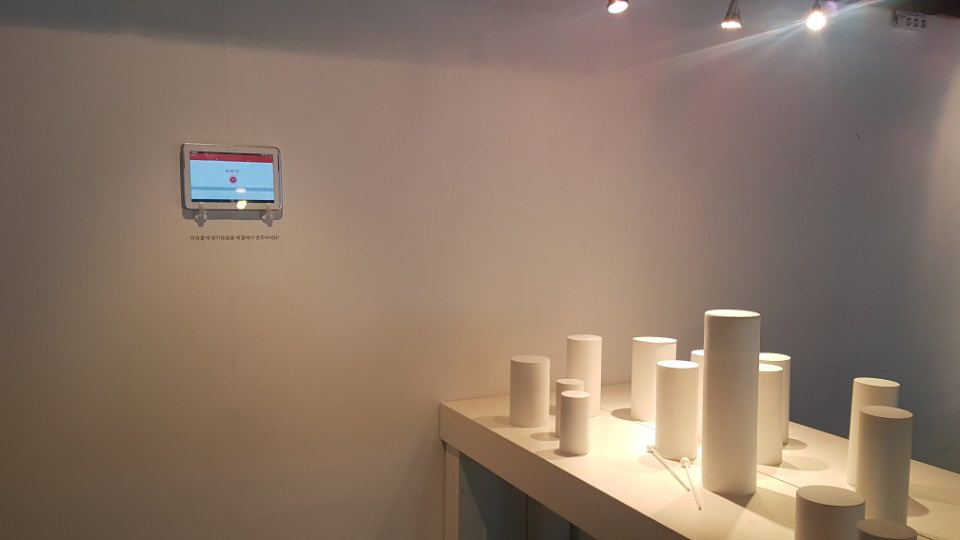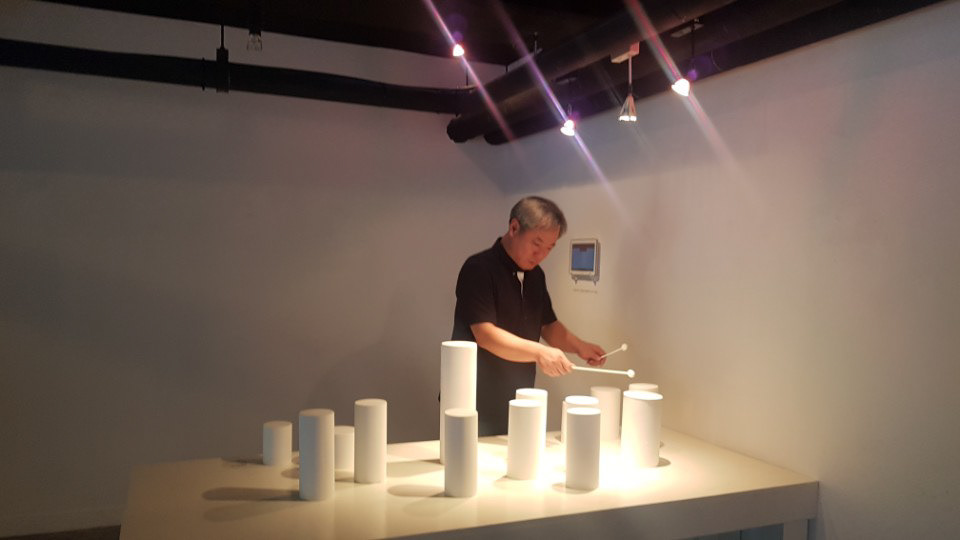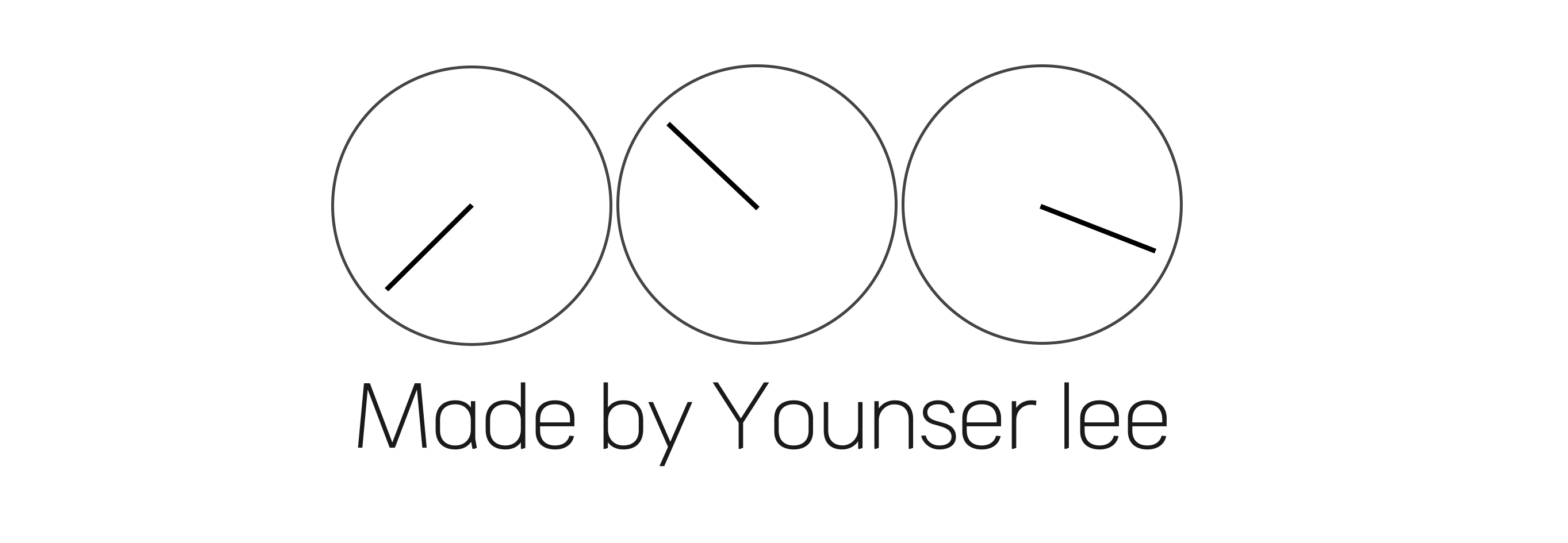What if 1: To buy _Video Installation
What if 1: To buy, 2017, Video Installation(Shopping carts, Steel, a bearing), 500*3500*947
In the course of our daily lives, we all make assumptions in many different situations. Shopping is the most representative example of assumptions we make in everyday life. Our shopping decisions tend to be repetitive, developing habits and assumptions of quality, as the ego of the human mind wants to view the choices it makes as the ‘right’ ones and create a constantly deepening brand and product loyalty. This project aims to shine a light on how people make assumptions and how they affect our daily consumption decisions. This interactive installation is designed explicitly with video footage to demonstrate the process of the shopping mindset and the eventual ‘reward’ that any given consumer will receive from the act of shopping itself.
Four shopping carts are connected to a center frame so that they can rotate. It lets people push a cart in various directions, but they cannot get out of the framed area, and eventually, the rotation becomes the same. In this installation, the framed structure represents a metaphorical meaning of the cycle of the assumption that people follow to decide whether or not to buy a product. To extend the metaphor, it also shows a video containing people who buy incorporeal things, and a wordless receipt is presented to signify that they do not actually consume anything. Thus, it emphasizes that people can see that the process of assumption, and eventual consumption by extension, is a product of their imaginations.
Four shopping carts are connected to a center frame so that they can rotate. It lets people push a cart in various directions, but they cannot get out of the framed area, and eventually, the rotation becomes the same. In this installation, the framed structure represents a metaphorical meaning of the cycle of the assumption that people follow to decide whether or not to buy a product. To extend the metaphor, it also shows a video containing people who buy incorporeal things, and a wordless receipt is presented to signify that they do not actually consume anything. Thus, it emphasizes that people can see that the process of assumption, and eventual consumption by extension, is a product of their imaginations.
Edited version of Interview: Past, Present, Future with English subtitles
What if 2: Past, present, and future, 2017, Chanel Video Installation
This project is a video installation with three interviews. Each video screen shows three interviewees’ dialogues about the past, present, and future. However, only present stories are played through the speaker so that the audience can clearly hear them.
The audience can pick only one story from all interviewees’ past and future stories and hear it through earphones. It emphasizes choosing one perspective for one story to make the audience feel the limits of time in the past and future. It contrasts itself by clearly showing the present videos from the other times. Therefore, people can understand that the present tense is more straightforward and more realistic, which helps them think of what we can actually see and understand in our own lives.
This set is designed to emphasize the present over the past or future to make them focus more on the present day rather than what has already passed or what is yet to come. The three video screens tell the present story via speakers in the exhibition space. The audience can only hear the three interviewees’ past and future stories through the earphones, and they can only select one of the past or future stories. Eventually, the audience is meant to realize that the present should hold most of their focus in their lives as well as in this installation.
The audience can pick only one story from all interviewees’ past and future stories and hear it through earphones. It emphasizes choosing one perspective for one story to make the audience feel the limits of time in the past and future. It contrasts itself by clearly showing the present videos from the other times. Therefore, people can understand that the present tense is more straightforward and more realistic, which helps them think of what we can actually see and understand in our own lives.
This set is designed to emphasize the present over the past or future to make them focus more on the present day rather than what has already passed or what is yet to come. The three video screens tell the present story via speakers in the exhibition space. The audience can only hear the three interviewees’ past and future stories through the earphones, and they can only select one of the past or future stories. Eventually, the audience is meant to realize that the present should hold most of their focus in their lives as well as in this installation.


What if 3: To beat 3, 2017, Mixed media, Changeable Installation
White cylinders are simple, sleek, and easily understandable. However, what if they were something more? I made this artwork to challenge the initial assumptions of the viewer when they see a set of white cylinders and come to judgments before the closer recognization.
The cylinders painted the same white color, are specifically designed to subvert the audience’s most basic expectations and present them with a whole new surprise. Despite the similar appearance, each of the white cylinders is made of a different material such as wood, plaster, steel, and plastic. Audience members are encouraged to move, manipulate, and even hit the cylinders to make different sounds. The audience interaction is also recorded on video to be shared with other audiences to compare reactions. This interaction art asks viewers to question their initial beliefs and judgments, which we often fail to do even when presented with contradictory evidence.
The cylinders painted the same white color, are specifically designed to subvert the audience’s most basic expectations and present them with a whole new surprise. Despite the similar appearance, each of the white cylinders is made of a different material such as wood, plaster, steel, and plastic. Audience members are encouraged to move, manipulate, and even hit the cylinders to make different sounds. The audience interaction is also recorded on video to be shared with other audiences to compare reactions. This interaction art asks viewers to question their initial beliefs and judgments, which we often fail to do even when presented with contradictory evidence.
